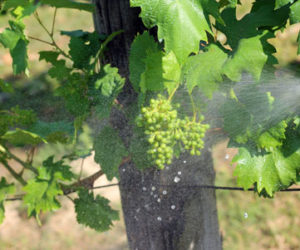What’s the best way to cure black rot?
Jake in Eastern Kentucky
I wish I could tell you that there’s a cure for black rot, but the best we can do is provide you with some control strategies. Grape black rot is caused by the fungus Guignardia bidwellii. Black rot survives the winter in cane and tendril lesions and fruit mummies, which are the leftover stems and skins of the grapes destroyed in previous years. In wet spring weather, the pycnidia on infected tissues absorb water and conidia are squeezed out. Conidia are moved by splashing raindrops and can infect any young tissue in less than 12 hours at temperatures between 60–90 °F (16–32 °C). Here are some common sense practices for control:
• Once a cluster has been infected, cut it off the vine and remove it from the vineyard area. Start with a clean vineyard with minimal spores from last year.
• Plant your grapes in open, sunny areas that have good airflow. Manage your canopy to allow as much sun and wind flow as the clusters can stand without burning or raisining.
• Be vigilant with your spray schedule, especially in the critical period between budbreak and bloom.
• Spray your vines with a recommended fungicide every ten to fourteen days. Captan, Benlate®, and Bordeaux mixture all do a good job protecting vines against infection. Follow fungicide labels for timing and dilution, and make sure to wear the proper safety equipment.
• Also make sure you’re getting enough pressure in your spray apparatus to get full coverage inside the canopy. A lot of home vineyardists get black rot even after spraying because the material is not being applied with adequate pressure for full penetration into the canopy.
• Most vineyards stop spraying when the grapes soften and change color. If you’ve kept the vineyard sanitary and removed all black rot spores, that’s a great start, and powdery mildew won’t grow on grapes once they reach about 18 °Brix. Black rot infection right before harvest is a tough problem because you don’t want fungicide ending up in your wine. Early detection, sanitation and sprays are vital.
I have four vines of Catawba grapes and one of them has essentially shut down. How can I determine if the vine has died, and can I replant another in the same location without worry?
Barry in Coraopolis Pennsylvania
Without looking at the symptoms of the vine, it’s difficult for me to make the call whether the vine is dead or not. What I usually do is to wait for budbreak and see if it wakes up out of its “coma.” If it doesn’t wake up next year, remove as much of the vine and the roots as you can and replant. If the replacement dies in a similar manner, there may be a problem with the soil or pests localized around that vine. Some organic compost heaped around the sick vine might be helpful in nursing it back to health.






